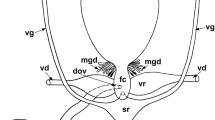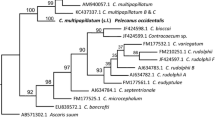Abstract
IN insects, two embryos developing within a common set of egg membranes may originate in several ways: by a splitting of the original embryonic primordium1; by production of a secondary primordium2,3; by naturally occurring polyembryony4; and by ovarian fusion of oocytes to produce composite eggs4,5. Oocyte fusions have been reported (or are assumed to have occurred) in several orders of insects5–9, but detailed embryological studies have been made only in phasmids (Orthoptera)5. This report is about the development of composite eggs in a laboratory stock of a paedogenetic parthenogenetic species of Miastor10. (Imagos are necessary for species determination in Miastor—although this stock has been under continuous observation since 1958, no adult midges have been found.) Fourteen composite eggs were found among some 12,000 eggs examined during investigations of embryogenesis in Miastor. Material consisted of whole mounts of eggs stained with borax carmine, and of sectioned material stained with iron haematoxylin or with Feulgen and fast green. The term “egg” as used throughout refers to the structure composed of the oocyte or embryo, the nurse cells and the surrounding follicle cells.
Similar content being viewed by others
References
Krause, G., Roux' Archiv Entwick. Mech., 146, 275 (1953).
Seidel, F., Biol. Zentralbl., 49, 577 (1929).
Sander, K., Roux' Archiv Entwick. Mech., 151, 660 (1960).
Counce, S. J., Ann. Rev. Entomol., 6, 295 (1961).
Cappe de Baillon, P., Encyclopedie Entomologique, 8 (Paul Lechevalier, Paris, 1927).
Tur, J., Bull. Biol. Fr. et Belg., 53, 37 (1920).
Balazuc, J., Mem. Mus. Nat'l. Hist. Natur., 25, 1 (1948).
Gill, K., J. Exp. Zool., 152, 251 (1963).
Brown, E. H., and King, R. C., Growth, 28, 41 (1964).
Nicklas, R. B., Chromosoma, 10, 301 (1959).
Kahle, W., Zoologica, 55, 1 (1908).
Reitberger, A., Chromosoma, 1, 391 (1940).
Hegner, R. W., The Germ Cell Cycle in Animals (Macmillan, New York, 1914).
Camenzind, R., Chromosoma, 18, 123 (1966).
Counce, S. J., Ann. NY Acad. Sci., 139, 65 (1966).
Author information
Authors and Affiliations
Rights and permissions
About this article
Cite this article
COUNCE, S. Development of Composite Eggs in Miastor (Diptera: Cecidomyidae). Nature 218, 781–782 (1968). https://doi.org/10.1038/218781a0
Received:
Issue Date:
DOI: https://doi.org/10.1038/218781a0
- Springer Nature Limited
This article is cited by
-
Cell fusions during formation of the oocyte-nurse chamber complex in the ovary of the dipteran insectMycophila speyeri
Wilhelm Roux's Archives of Developmental Biology (1983)
-
Dicephalic ? ADrosophila mutant affecting polarity in follicle organization and embryonic patterning
Wilhelm Roux's Archives of Developmental Biology (1982)
-
Contribution of germ-line cells to formation of the nurse chamber in egg follicles of nonpaedogenetic gall midges (Diptera, Cecidomyiidae)
Experientia (1979)
-
Composite eggs in non-paedogenetic gall midges (Cecidomyiidae, Diptera)
Wilhelm Roux's Archives of Developmental Biology (1978)
-
The origin of the nurse chamber in ovaries ofMiastor (Diptera: Cecidomyidae)
Wilhelm Roux’ Archiv für Entwicklungsmechanik der Organismen (1974)





